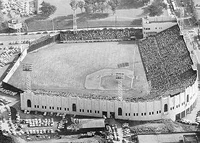| Seals Stadium | |
|---|---|
 | |
| Location | San Francisco, California |
| Opened | April 7, 1931 |
| Closed | September 20, 1959 |
| Demolished | November, 1959 |
| Owner | San Francisco Seals |
| Surface | Grass |
| Construction cost | $600,000 |
| Tenants | |
| San Francisco Seals (PCL) (1931-1957) Mission Reds (PCL) (1931-1937) San Francisco Giants (MLB) (1958-1959) | |
| Capacity | |
| 16,000 (1931) 18,500 (1946) 22,900 (1958) | |
| Dimensions | |
| Left Field - 340 ft (1931), 365 ft (1958), 361 ft (1959) Left-Center - 375 ft (1958), 364 ft (1959) Center Field - 400 ft (1931), 410 ft (1958), 400 ft (1959) Right-Center - 397 ft (1958) Right Field - 385 ft (1931), 365 ft (1940), 355 ft (1958), 350 ft (1959) | |
Seals Stadium was a minor league baseball stadium that stood in San Francisco from 1931 through 1959.
Built during the depression, Seals Stadium opened on April 7, 1931, It cost $600,000 to construct, and Seals President "Doc" Strub described how laborers would leap onto the running boards of his automobile and beg for the opportunity to work on the project for $3 a day. The stadium was unusual in that it was built with three dressing rooms - one for the visiting team, and one for each of the minor league home teams, the San Francisco Seals and the Mission Reds, a.k.a the San Francisco Missions. It was built for night games, with six tower banks which were described as the best in minor league baseball at the time. With a capacity of 18,600, the stadium had no roof over the grandstands because of San Francisco's lack of rainfall during the summertime and the fans' preference to sit in the sun.[1]
The San Francisco Missions vacated the stadium in 1938, moving to the Los Angeles area and changing their name to the Hollywood Stars.
The stadium initially consisted of an uncovered grandstand stretching from foul pole to foul pole and an uncovered bleacher section in right field. In some years during its minor league days, a live seal was kept in a water tank underneath the grandstand.

Shopping center at the site of Seals Stadium, 2011.
A separate uncovered bleacher section was added in left field when the New York Giants moved to the city in 1958. The Giants played at Seals Stadium for two years while Candlestick Park was under construction. Given the temporary nature of their stay at the old park, they declined to rename the stadium. Throughout the ballpark's MLB tenure, it had no warning track.[2]
With the new ballpark safely nearing completion, Seals Stadium was demolished in November 1959. Many of the seats and the light stanchions were reused at Cheney Stadium in Tacoma, Washington. From the late 1960s to the mid-1970s, the site was a White Front discount department store. The store was subdivided into smaller shops after White Front went bankrupt. For many years afterward, the site (bounded by Bryant Street, 16th Street, Potrero Avenue and Alameda Street) housed several San Francisco automobile dealerships after the demise of Van Ness Avenue's famed Auto Row in 1982. In the late 1990s it was converted to a shopping center which includes a Safeway grocery store. Coincidentally, Peter Magowan, whose grandfather was an early investor in Safeway and his father its chairman and CEO, became one of the owners of the Giants in 1993.
References[]
- ↑ The Sporting News "Take Me Out To The Ball Park", 2nd Edition, 1987 by Lowell Reidenbaugh - p 230
- ↑ Lowry, Philip (2006). Green Cathedrals. Walker & Company.
External links[]
- 1931 Aerial View showing Seals Stadium (toward lower right) and the Seals' prior home Recreation Park (toward upper left)
